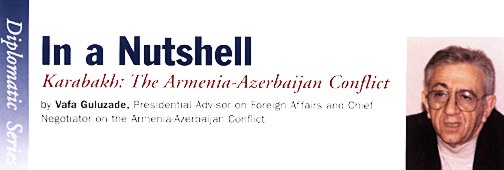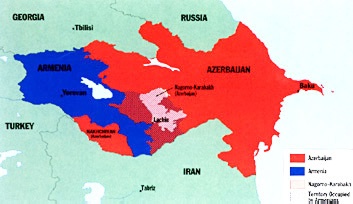|
Summer 1998 (6.2)
Reprinted with permission from USACC Investment Guide 1998. Tragically, the scenic mountainous enclave of Nagorno-Karabakh is currently held under military occupation by Armenians. Vafa Guluzade provides a concise overview of the history of the conflict.
The conflict was escalated by Russia's political and military support of Armenia. Russia is using the Armenia-Azerbaijan conflict as part of its long-time policy of "divide and conquer." Since 1993, Armenia has received $1 billion in arms shipments from Russia. These arms, including the most modern Russian tanks, armored personnel carriers, SCUD missiles and tons of ammunition, were shipped through Armenia to the site of the conflict inside Azerbaijan. A series of Armenian offensives, beginning in 1992 and backed by Russian arms, resulted in the Armenian occupation of almost 20 percent of Azerbaijan territory, including Nagorno-Karabakh and seven other districts. As a result, Azerbaijan is left with approximately 1 million refugees and internally displaced persons (IDPs) who were forced to flee for their lives. A cease-fire was negotiated in May 1994, but all attempts to negotiate a settlement have failed. The Organization for Security and Cooperation in Europe (OSCE) began its mediation efforts in 1992, and in 1995 at a summit meeting in Lisbon, 53 out of 54 member states of the OSCE endorsed a statement of three principles upon which the conflict should be settled. Armenia was the only country that refused to support the statement because it supported the territorial integrity of Azerbaijan and Armenia [meaning that the original borders from the Soviet period must remain intact]. In 1996, the OSCE appointed three co-chairs to its Minsk Conference-the United States, Russia and France. The Minsk Conference is charged with the responsibility of negotiating peace in this region. These co-chairs then developed a two-staged peace proposal: (1) withdrawal of Armenian forces from all regions of Azerbaijan except Nagorno-Karabakh; and (2) negotiations on the final status of Nagorno-Karabakh [as an entity] within Azerbaijan. This proposal was accepted by Azerbaijan and by Armenian President Levon Ter-Petrossian. However, it was opposed by hard-line elements within Armenia and ethnic Armenians within Nagorno-Karabakh. As a result, President Ter-Petrossian was forced from office, replaced by hard-line elements. Now the peace process is up in the air again. Azerbaijan remains committed to a peaceful solution based on the following Lisbon principles: (1) recognition of territorial integrity of the Republic of Azerbaijan and the Republic of Armenia; (2) Azerbaijan will grant the highest level of self-rule to Nagorno-Karabakh; and (3) security guarantees will be provided to the entire population of Nagorno-Karabakh [meaning that Azerbaijanis could return home to their lands safely but that Armenians would also be protected as residents there]. Nagorno-Karabakh is an enclave inside Azerbaijan, and has no border with Armenia. Before the conflict started, Armenia deported some 200,000 Azerbaijanis from Armenia. Then it occupied the whole territory of Nagorno-Karabakh and surrounding seven regions and, in effect, has annexed Nagorno-Karabakh and this territory to Armenia. In the process all Azerbaijanis previously living in these regions which belong to Azerbaijan were forced to flee for their lives. It might be noted that even the Nazis allowed inhabitants of their occupied territories to stay and live there. But Armenians have rid Azerbaijanis from the entire occupied territories. Khojaly, a small Azerbaijani town in Nagorno-Karabakh, is a sad example of genocide, when overnight the whole town was destroyed, more than 700 innocent civilians, including many women and children, were murdered and others were forcefully deported. The President of Azerbaijan has subsequently declared March 31 as the Day of Genocide of Azerbaijanis in commemoration of that occasion and other earlier tragic massacres. Azerbaijan has accepted and
supported all peace initiatives of the OSCE. Now, Armenia must
decide whether it wishes to further isolate itself from the rest
of the world community or join in seeking a just and honorable
compromise to this 10-year old conflict. |


 The
current conflict between Armenia and Azerbaijan began in 1988,
when the ethnic Armenians of Nagorno-Karabakh unilaterally declared
their independence from Azerbaijan, with the intent of uniting
with the Republic of Armenia. At that time, ethnic Armenians
comprised about 65 percent of Nagorno-Karabakh. This push by
the ethnic Karabakh Armenians to secede from Azerbaijan was instigated
by Armenia, which has had territorial claims against Azerbaijan
as part of its desire to create a Greater Armenia by expanding
its territory. Armenian soldiers and arms are being used to carry
out this policy.
The
current conflict between Armenia and Azerbaijan began in 1988,
when the ethnic Armenians of Nagorno-Karabakh unilaterally declared
their independence from Azerbaijan, with the intent of uniting
with the Republic of Armenia. At that time, ethnic Armenians
comprised about 65 percent of Nagorno-Karabakh. This push by
the ethnic Karabakh Armenians to secede from Azerbaijan was instigated
by Armenia, which has had territorial claims against Azerbaijan
as part of its desire to create a Greater Armenia by expanding
its territory. Armenian soldiers and arms are being used to carry
out this policy.